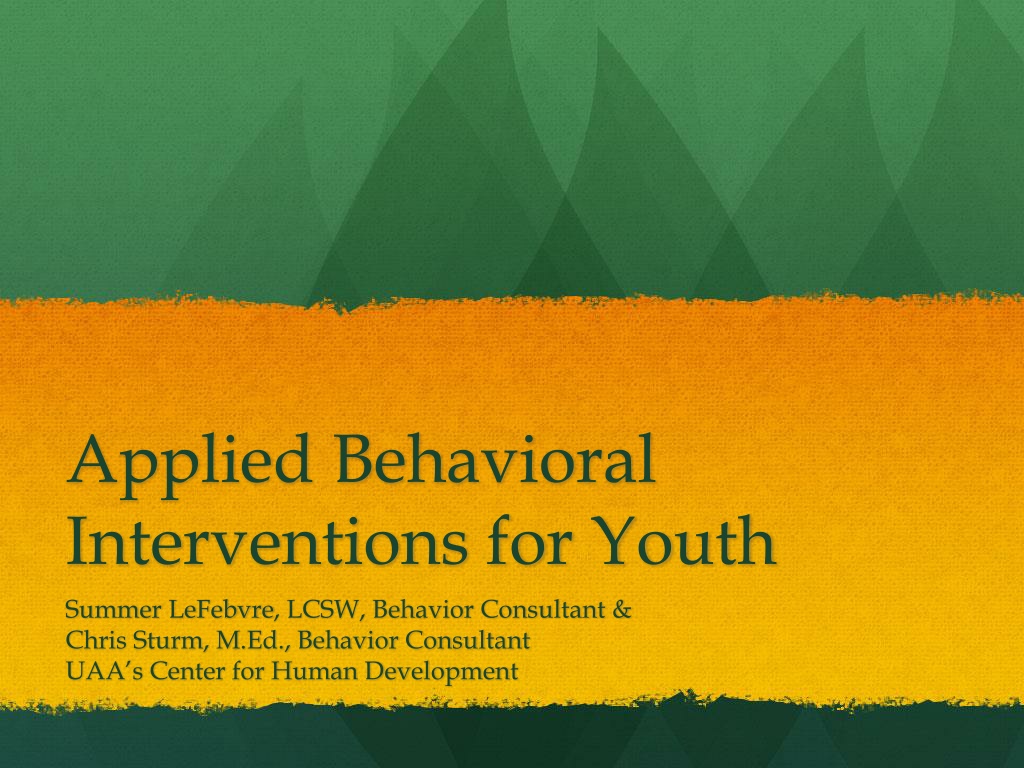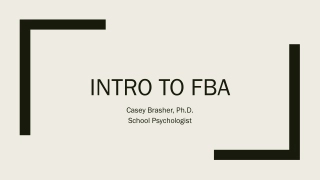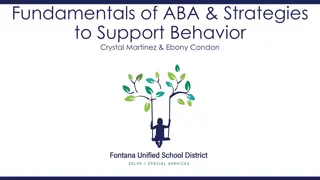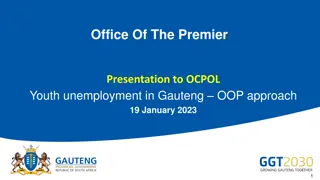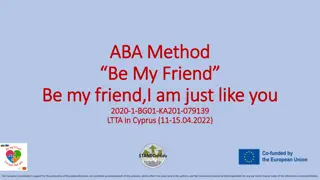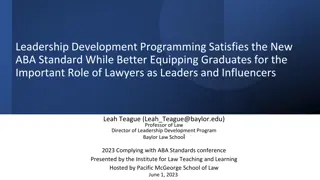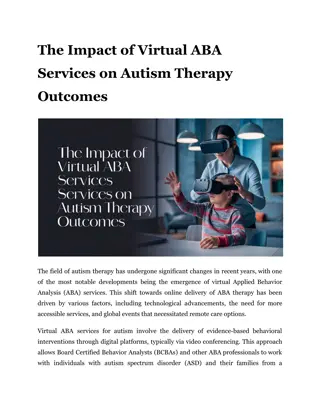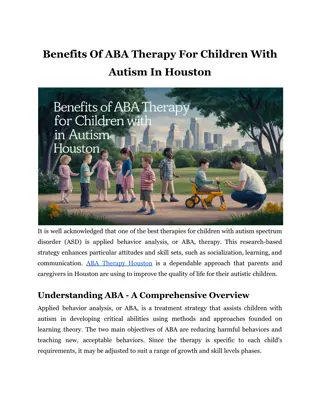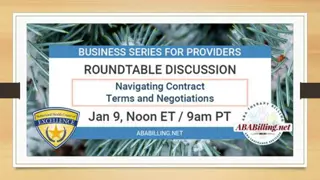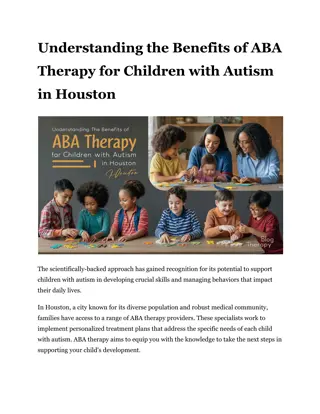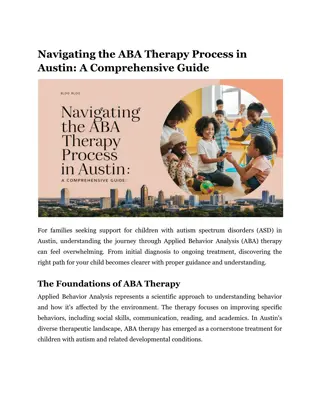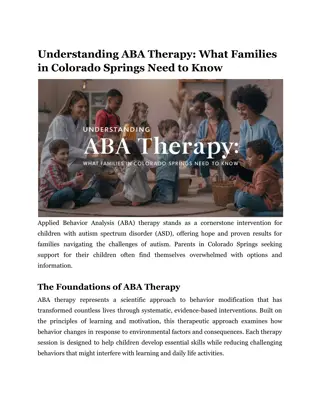Understanding Applied Behavior Analysis (ABA) for Youth Interventions
Applied Behavior Analysis (ABA) is a science focusing on improving human behavior by increasing desired behaviors, teaching new skills, and generalizing behaviors. ABA emphasizes observable behaviors, measurement of behavior change, and the use of interventions in various settings like classrooms and homes. It involves analyzing antecedents, behaviors, and consequences to manage behavior effectively.
Download Presentation

Please find below an Image/Link to download the presentation.
The content on the website is provided AS IS for your information and personal use only. It may not be sold, licensed, or shared on other websites without obtaining consent from the author. Download presentation by click this link. If you encounter any issues during the download, it is possible that the publisher has removed the file from their server.
E N D
Presentation Transcript
Applied Behavioral Interventions for Youth Summer LeFebvre, LCSW, Behavior Consultant & Chris Sturm, M.Ed., Behavior Consultant UAA s Center for Human Development
What is Applied Behavior Analysis? ABA is a science focused on the understanding and improvement of human behavior Using ABA we: Increase behaviors Teach new skills/behaviors Generalize behaviors to new situations Maintain new behaviors Reduce the complex, interfering behaviors Limit conditions where the complex behavior occurs
ABAs Focus ABA focuses on Behavior and its relationship to the environment what we all can see Clearly and explicitly defined procedures to describe how to change behavior Laws of behavior that have been experimentally demonstrated Primarily reinforcement and not punishment procedures
ABA is A = Applied Applied settings are used, such as: Classrooms Home environment Community settings Analyze Antecedents & Consequences What happens right before the behavior? Right after? What is in the environment that makes challenging behavior easier and more effective for that person ? The focus is on socially important behaviors.
ABA is B = Behavior Behavior means everything we do Behavior is lawful Behavior can be defined, observed, predicted, and managed and agreed upon by everyone Behavior is influenced by events and people just before and after the behavior has occurred This Includes Social Behavior
More About B = Behavior ABA Increase specific behaviors Decrease others BUT in positive ways (not through punishment procedures) So when considering what behaviors to decrease, think of a new, more appropriate easy behavior to be increased This easy behavior takes the place of the behavior decreased the Replacement Behavior
Behavior Analysis & Interventions Focus is on observable behavior Measurement of behavior change Emphasis on current environmental events and surrounding (including people) Antecedents Behaviors Consequences Behaviors are defined by their dimensions or properties Intervention procedures are clearly described Intervention implemented by people in everyday situations at home, in the community, at school
ABA is A = Analysis ABA is based upon daily data collection of challenging behaviors, interventions implemented and if Behavior(s) were increased? Behavior(s) were decreased? Treatment decisions are based on real-time, daily measurement of behavior Show me the DATA
Visualizing Problem Areas Communication Communication Social Skills Behavior Social Skills Behavior
Primary Tool the FBA FBA is a Functional Behavioral Assessment Not similar at all to the Functional Assessment (FA) During this process, the following is done: 1) Review of records and previous interventions 2) Interviews of individual, family, providers, other stakeholders 3) Direct observation across environments
Functional Behavioral Assessment 1) Operationally define problem behavior(s) 2) Identify events/situations which predict when the problem behavior will/won t occur 3) Identify the function the behavior(s) seem to serve 4) Develop summary statements which describe the behaviors, situations in which they occur, and what is maintaining them What s reinforcing the behavior(s)? 5) Direct observation to see if the function is correct Show me the DATA
Behavior Intervention Plan (BIP) The BIP is developed collaboratively by the TEAM: 1) FBA results reviewed 2) Determine the Replacement & Preferred behaviors 3) Individual intervention for problem behavior What and how will new behaviors be prompted? 4) Programmatic interventions for team members What will staff do to actively prevent challenging behaviors and prompt for new behaviors? 5) Progress monitoring Daily data collection & On-going evaluation
Behavior Serves 4 Broad Functions Access to attention (GET) Access to a tangible item (GET) Food, Events, Games, People Escape (GET AWAY) Attention, Demands, Non-preferred activities Automatic (GET) Self-stimulatory (not socially regulated)
Interaction is Bi-directional Your/Staff/Caregiver behavior impacts your client. Your client protests and he gets out of doing dishes. Your client learns to protest to get out of chores.
Interaction is Bi-directional Your client s behavior impacts you. Your client quits protesting when you let him out of doing dishes. You are more likely to allow him to escape chores to prevent/stop/remove protesting.
Interaction is Bi-directional Peers behavior impacts your client. Your client ignores her peer when they approach to talk. Your client learns if she doesn t respond, the other person will leave her alone.
Interaction is Bi-directional Your client s behavior impacts peers. Your client does not respond to peer s initiation. The peer is less likely to approach because their initiations are not reinforced by your client.
Changing the Interaction Because we know behavior is lawful It can be defined, observed, predicted, and managed, and It is influenced by events that happen after the behavior has occurred We can intervene and change it!
ABCs of Behavior Antecedent What happens right before the behavior? What in the environment tells the client something is here for me if I do X? Behavior The only behaviors of concern are socially important and socially relevant behaviors. Consequence What happens right after? (reinforcing or maintaining consequence) Consequence is important, but not for the reasons you think We need to find out what people get out doing something. What is the behavior trying to tell us? What is the function of that behavior?
ABCs or the 3-Term Contingency Big Bang Theory with Sheldon & Penny https://www.youtube.com/watch?v=qy_mIEnnlF4 Sheldon s Antecedent What does he do/say that makes him the A? Penny s behavior What does she do in response? What is the C?
Observable A-B-Cs By looking at what happened right before and after a behavior we understand the relationship between the environment and behavior A B C Antecedent Behavior Consequence Antecedents Behavior Consequence Son told No he can t use the car Daughter told to do a chore Son argues Dad gives in and gives him the keys Parent gets upset She mumbles & complains
Impacting Behavior Reinforcement/Punishment
One Point about Consequences We do something to get something Consequences are important, but not for what you might be thinking like teaching a lesson Consequences tell us what people get from their behavior What is the behavior trying to tell us? What is the function of that behavior?
ABC Wrap-Up ABCs are also known as the 3-Term Contingency Behavior does not occur in isolation. It is affected by events that happen before and events that happen after. In order to gain a clearer understanding of what is maintaining a behavior, we must look at all three pieces. Antecedent Behavior Consequence
Questions/ Comments Contact information Summer LeFebvre, LCSW, Behavior Consultant summer@alaskachd.org (907) 350-1257 Chris Sturm, M.Ed., Behavior Consultant chris@alaskachd.org (907) 891-1012 UAA s Center for Human Development 2702 Gambell Street, Suite #103 Anchorage, Alaska 99503
